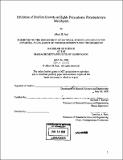Inhibition of biofilm growth on highly polycationic polyelectrolyte multilayers
Author(s)
Park, Albert H
DownloadFull printable version (14.11Mb)
Other Contributors
Massachusetts Institute of Technology. Dept. of Materials Science and Engineering.
Advisor
Michael F. Rubner.
Terms of use
Metadata
Show full item recordAbstract
The epithelial cell adhesion molecule E-cadherin is often down regulated during carcinoma progression and metastatic spread of tumors. However, the precise mechanism and molecular basis of metastasis promotion by E-cadherin loss is not completely understood. To investigate its role in metastasis, I utilized two distinct methods of E-cadherin inhibition that distinguish between E-cadherin's cell-cell adhesion and intracellular signaling functions. While the disruption of cell-cell contacts alone does not enable metastasis in vivo, the loss of E-cadherin protein does, through induction of an epithelial-to-mesenchymal transition (EMT), invasiveness and anoikis-resistance. E-cadherin binding partner f3-catenin is necessary but not sufficient for these phenotypes. In addition, gene expression analysis shows that E-cadherin loss results in the induction of multiple transcription factors, at least one of which, Twist, is necessary for E-cadherin loss-induced metastasis. These findings indicate that E-cadherin loss in tumors contributes to metastatic dissemination by inducing wide-ranging transcriptional and functional changes. In addition to promoting metastasis, loss of E-cadherin and the accompanying EMT renders cells resistant to conventional chemotherapeutic drugs. As the cells that have undergone an EMT represent the pool of cancer cells most competent to metastasize and lead to tumor recurrence, it is of vital importance to find therapies that effectively target such cells. Paired cell lines that differ in their differentiation state were utilized to discover compounds with selective toxicity against cells that have undergone an EMT. High-throughput screening of small molecule libraries resulted in a number of compounds that specifically affect the viability of cells that have undergone an EMT while having minimal cytotoxic effects on control epithelial cells. These studies establish a proof-of-principle for discovering compounds that target highly metastatic and otherwise chemotherapy resistant cancer cells.
Description
Thesis (S.B.)--Massachusetts Institute of Technology, Dept. of Materials Science and Engineering, June 2008. "May 16, 2008." Includes bibliographical references.
Date issued
2008Department
Massachusetts Institute of Technology. Department of Materials Science and EngineeringPublisher
Massachusetts Institute of Technology
Keywords
Materials Science and Engineering.